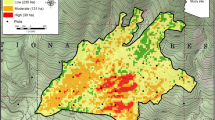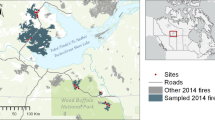Abstract
In southern California, wildfire is a ubiquitous agent shaping plant communities. Although fire impacts have been widely studied in chaparral-covered uplands, few data are available regarding fire and riparian vegetation. This study provides an example of the impact of a severe fire on riparian habitat. Plant species found in southern California gallery forests are typically adapted to maintaining populations following flood disturbances; we seek to determine whether structural and compositional changes following fire here demonstrate a similar quasi-equilibrium response. We sampled 65 quadrats on 11 transects along two streams in the Los Padres National Forest to characterize tree species size–class distributions before and after the 2002 Wolf Fire. We tested whether species exhibited differential patterns of survivorship and regeneration following the fire, and also tested for spatial variability in mortality within the floodplain. Alnus rhombifolia dominated the pre-fire forest, but experienced severe mortality in the fire and showed very limited resprouting after 3 years. Other prominent taxa (Populus, Salix, Quercus spp.) also lost considerable standing basal area, but had substantially greater rates of resprouting, resulting in a dramatically altered post-fire vegetation composition and structure. Fire impacts did not vary with landform position, leading to a distinctive homogenizing disturbance that contrasts with the spatially zoned and relatively stabilizing compositional influence that flood events have in this same riparian setting.





Similar content being viewed by others
References
Baltz D, Moyle P. 1984. The influence of riparian vegetation on stream fish communities of California. In: Warner RE, Hendrix KM, Eds. California riparian systems. Berkeley: University of California Press. p 183–7.
Bendix J. 1994. Among-site variation in riparian vegetation of the southern California Transverse Ranges. Am Midl Nat 132:136–51.
Bendix J. 1998. Impact of a flood on southern Californian riparian vegetation. Phys Geogr 19:162–74.
Bendix J. 1999. Stream power influence on southern Californian riparian vegetation. J Veg Sci 10:243–52.
Bendix J, Cowell CM. Forthcoming. Fire, floods and woody debris: Interactions between biotic and geomorphic processes. Accepted for publication in Geomorphology.
Bendix J, Hupp CR. 2000. Hydrological and geomorphological impacts on riparian plant communities. Hydrol Process 14:2977–90.
Bond WJ, van Wilgen BW. 1996. Fire and plants. London: Chapman & Hall. p 263.
Cattelino PJ, Noble IA, Slatyer RO, Kessell SR. 1979. Predicting the multiple pathways of succession. Environ Manage 3:41–50.
Charron I, Johnson EA. 2006. The importance of fires and floods on tree ages along mountainous gravel-bed streams. Ecol Appl 16:1757–70.
Cowell CM, Dyer JM. 2002. Vegetation development in a modified riparian environment: human imprints on an Allegheny River wilderness. Ann Assoc Am Geogr 92:189–202.
Davis FW, Keller EA, Parikh A, Florsheim J. 1989. Recovery of the chaparral riparian zone after wildfire. Abell DL technical coordinator. Proceedings of the California riparian systems conference. United States Forest Service General Technical Report PSW-110. p 194–203.
Dwire KA, Kauffman JB. 2003. Fire and riparian ecosystems in landscapes of the western USA. For Ecol Manage 178:61–74.
Ellis LM. 2001. Short-term response of woody plants to fire in a Rio Grande riparian forest, central New Mexico, USA. Biol Conserv 97:159–70.
Erman NA. 1984. The use of riparian systems by aquatic insects. In: Warner RE, Hendrix KM, Eds. California riparian systems. Berkeley: University of California Press. p 177–82.
Franzreb KE. 1990. An analysis of options for reintroducing a migratory, native passerine, the endangered Least Bell’s Vireo Vireo bellii pusillus in the Central Valley, California. Biol Conserv 53:105–23.
Holstein G. 1984. California riparian forests: deciduous islands in an evergreen sea. In: Warner RE, Hendrix KM, Eds. California riparian systems. Berkeley: University of California Press. p 2–22.
Keeley JE, Fotheringham CJ. 2001. Historic fire regime in southern California shrublands. Conserv Biol 15:1536–48.
Keeley JE, Fotheringham CJ, Morais M. 1999. Reexamining fire suppression impacts on brushland fire regimes. Science 284:1829–32.
Keeley JE, Pfaff AH, Safford HD. 2005. Fire suppression impacts on postfire recovery of Sierra Nevada chaparral shrublands. Int J Wildland Fire 14:255–65.
Knopf FL, Johnson RR, Rich T, Samson FB, Szaro RC. 1988. Conservation of riparian ecosystems in the United States. Wilson Bull 100:272–84.
Kobziar LN, McBride JR. 2006. Wildfire burn patterns and riparian vegetation response along two northern Sierra Nevada streams. For Ecol Manage 222:254–65.
Mueller-Dombois D, Ellenberg H. 1974. Aims and methods of vegetation ecology. New York: Wiley and Sons. p 547.
Lytle DA, Poff NL. 2004. Adaptation to natural flow regimes. Trends Ecol Evol 19:94–100.
Olson TE, Gray MV. 1989. Characteristics of Least Bell’s Vireo nest sites along the Santa Ynez River. In: Abell DL technical coordinator. Proceedings of the California riparian systems conference. United States Forest Service General Technical Report PSW-110. p 278–84.
Pettit NE, Naiman RJ. 2007a. Fire in the riparian zone: characteristics and ecological consequences. Ecosystems 10:673–87.
Pettit NE, Naiman RJ. 2007b. Postfire response of flood-regenerating riparian vegetation in a semi-arid landscape. Ecology 88:2094–104.
Powell BF, Steidl RJ. 2000. Nesting habitat and reproductive success of southwestern riparian birds. Condor 102:823–31.
Scott ML, Skagen SK, Merigliano MF. 2003. Relating geomorphic change and grazing to avian communities in riparian forests. Conserv Biol 17:284–96.
Stella JC, Battles JJ, Orr BK, McBride JR. 2006. Synchrony of seed dispersal, hydrology and local climate in a semi-arid river reach in California. Ecosystems 9:1200–14.
Stromberg JC. 2006. Seasonal reversals of upland-riparian diversity gradients in the Sonoran Desert. Divers Distrib 13:70–83.
Stromberg JC, Rychener TJ, Dixon MD. 2009. Return of fire to a free-flowing desert river: effects on vegetation. Restor Ecol 17:327–38.
Szaro RC, Jakle MD. 1985. Avian use of a desert riparian island and its adjacent scrub habitat. Condor 87:511–19.
Turner MG, Romme WH, Gardner RH, O’Neill RV, Kratz TK. 1993. A revised concept of landscape equilibrium: disturbance and stability on scaled landscapes. Landsc Ecol 8:213–27.
Tyler CM, Kuhn B, Davis FW. 2006. Demography and recruitment limitations of three oak species in California. Q Rev Biol 81:129–52.
Whipple SA, Dix RL. 1979. Age structure and successional dynamics of a Colorado subalpine forest. Am Midl Nat 101:142–58.
Wolf BAER Team. 2002. Wolf Fire—periodic progression. 1:63360 scale map. Ojai Ranger District, Los Padres National Forest.
Acknowledgments
Funding was provided by a grant from the Appleby-Mosher Fund in the Maxwell School at Syracuse University, and by faculty development grants from Syracuse University and the University of Missouri. Fieldwork was also supported by the US Forest Service; we thank Dr. Mark Borchert of the US Forest Service for coordinating that support, for many stimulating discussions, and for his hospitality in Ojai. We thank Joseph Stoll of the Syracuse University Cartographic Laboratory for preparation of the figures, and Anna Lumsden for research assistance. We are particularly indebted to Dr. John Stella and to the anonymous reviewers for thoughtful comments and suggestions.
Author information
Authors and Affiliations
Corresponding author
Additional information
Author contributions
J. Bendix conceived the study. J. Bendix and C. M. Cowell obtained funding and conducted fieldwork. J. Bendix analyzed the data and wrote the paper, with contributions from C. M. Cowell.
Rights and permissions
About this article
Cite this article
Bendix, J., Cowell, C.M. Impacts of Wildfire on the Composition and Structure of Riparian Forests in Southern California. Ecosystems 13, 99–107 (2010). https://doi.org/10.1007/s10021-009-9303-z
Received:
Accepted:
Published:
Issue Date:
DOI: https://doi.org/10.1007/s10021-009-9303-z




